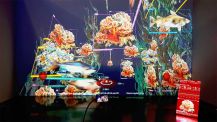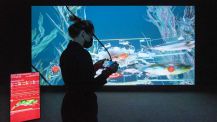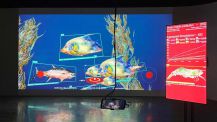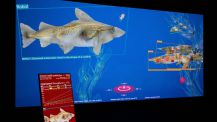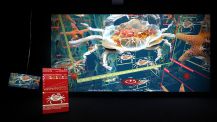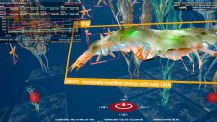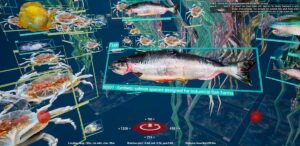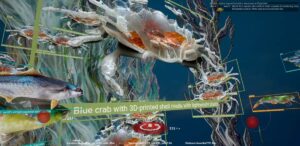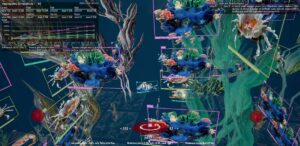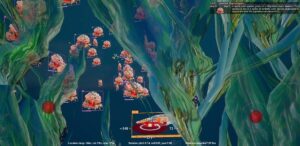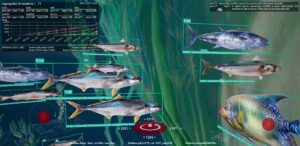Mobile App as Interface for Interactive Installations
Due to accelerating acidification and industrial aquafarming, our ocean is becoming increasingly uninhabitable. Aquaculture workers and scientists now rely on genetic engineering, synthetic biology, and machine learning as potential tools to mitigate climate change. YANTO – yaw and not tip over imagines a speculative aquaculture farm 30 years from now, where artificial intelligence creates synthetic species to withstand the increasingly hostile ocean environment. Through the point-of-view of an A.I. simulator, the audience is invited to swim with the mutated species and observe a changing ecosystem.
Each speculative species has a backstory rooted in real-life scenarios: the shellfish would slowly lose their ability to form shells in acidified water; the tropical species would lose their vibrant colors in extreme heat; the fish would lose their sense of orientation due to high PH. We imagine a future where technologies like 3D printing, CRISPR, and synthetic biology play a part in modifying species for a higher chance of survival. Shellfish with 3D-printed shells, tropical fish with artificial fins, and shrimp with kelp DNA for a low PH – with an image generation adversarial network, we created these hybrid creatures based on their real-life counterparts.
Description
In Unruly Appetites: Salmon Domestication “All the Way Down” (Lien, 2017), Marianne Elisabeth Lien investigated the delicate dance of balancing an aquafarm ecosystem: to reduce sea lice in a crowded salmon population, fish farmers introduced wrasse as a cleaner species, which in turn requires “artificial kelp” (plastic stripes in this case) to act as a habitat. By introducing new species, humans learn to balance the system to maximize profit – and it’s not hard to imagine a not-so-distant future where machine learning does the balancing act of optimizing for human objectives.
In Under a White Sky, author Elizabeth Kolbert pointed to “control” as the fundamental logic of the Anthropocene: “If control is the problem, still more control must be the solution.” YANTO responds to the trend of technology-assisted solution-making by constructing an uncomputable system under extreme control – what do we optimize, and who do we optimize for? The project aims to inspect our tendency to treat nature as a system that can be fixed.
Audience Experience and Impact
The audience interact with the installation through a mobile interface and navigate through a speculative underwater environment with a smartphone. This virtual environment is endless and can be navigated in every direction. The sonic sound experiences are specially composed for this aquafarming simulation and respond to all movements and navigation modes. In the exhibition space, the display of the smartphone could be projected onto a large wall.
Through the point-of-view of an A.I. simulator, the audiences are invited to swim with the engineered/mutated species, and create new simulations to observe the changing ecosystem. When the audience approaches a species, they will have the chance to learn about the species’ backstory. We hope to invite the audience to investigate our tendency to engineer nature and treat ecosystems as a system that can be fixed.
Screenshots
Credits
Iris Qu Xiaoyu, Marc Lee and Shervin Saremi (sound)
Iris Qu Xiaoyu (b. 1993, China) is an artist and technologist based in Brooklyn, NY, working at the intersection of software engineering and new media art. With code as her primary medium, her work engages with the speculative, political, and poetic aspects of technology. Her current research focuses on the hidden cost of optimization in machine learning systems.
Shervin Saremi is an Iranian musician and audio-engineer, working in fields such as sonic computing, procedural sound design, and production. He has studied Electronic Production and Design at Berklee College of Music and is pursuing his research on immersive audio at Berlin University of the Arts (UdK).
